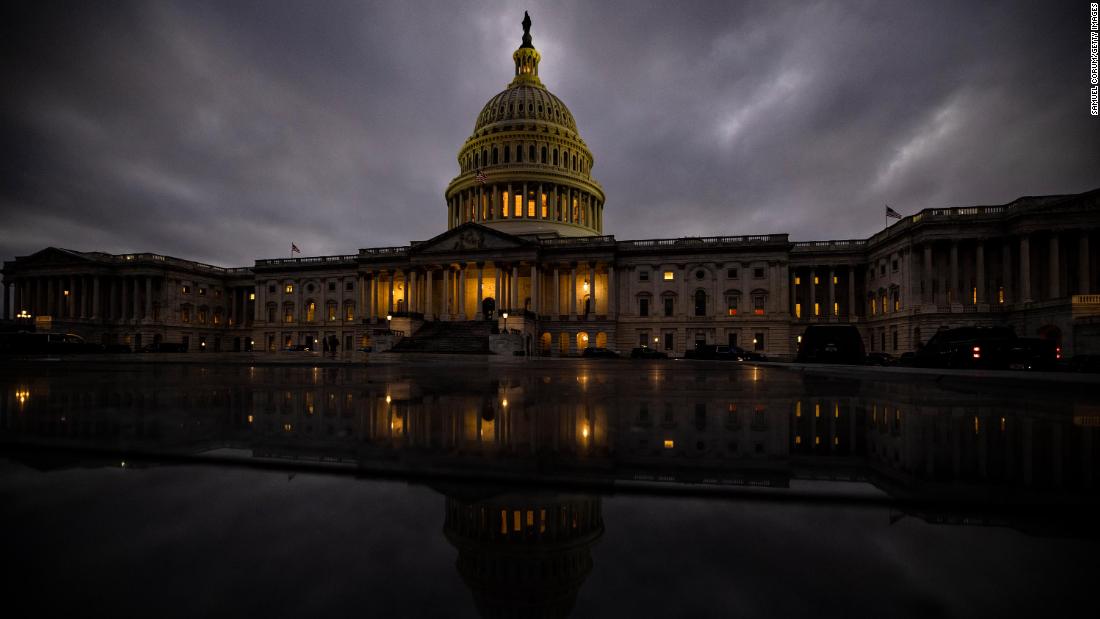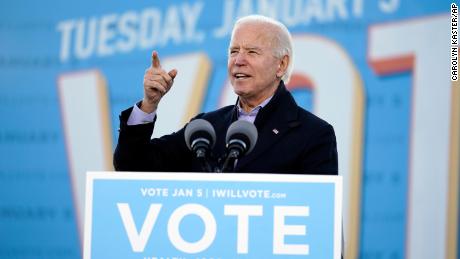Analysis: The Senate will become more volatile, regardless of today’s Georgia elections
Even if Republicans win both races, they will control the Senate majority with only 52 seats. If Democrats win both, they will eke out a 50-50 Senate majority with the tie-breaking vote of incoming Vice President Kamala Harris. A split would produce a 51-49 GOP majority.
The fact that neither side will control more than 52 seats after Tuesday means that either party has held at least 55 Senate seats in only three congressional sessions since 2000. By contrast, in the previous 20-year span, one party reached 55 seats or more in seven congressional sessions. In fact, the meager three majorities of 55 seats or more since 2000 represent the fewest times that any party has accumulated at least 55% of the Senate seats over a 20-year span since the turn of the 20th century, according to official Senate records.
The inability of either side to build a big cushion has contributed to a historic level of volatility in Senate control, with neither party holding the majority for more than eight consecutive years since 1980, a span of turnover unprecedented in American history.
“The closeness of it, I think, is good for the center, and I think it’s good for Joe Biden because he’s a product of the center,” says John Breaux, a former centrist Democratic senator from Louisiana who is now a Washington lobbyist. Biden “understands the Senate. He grew up in the Senate; he knows that you have to talk to both sides. So I think the closeness of it — whether it’s 52-48 or 50-50 or 51-49 — is probably good for him and good for the country, because he is going to know how to deal in that type of a Senate.”
But other observers note that the narrow Senate majorities of recent years have, in practice, produced very few bipartisan compromises. Instead, they say the slim advantages — and regular shifts in control — have intensified the chamber’s growing partisanship. With control constantly at risk, the majority party faces heightened pressure for lockstep unity, while the minority party never has much incentive to help the majority burnish its record with bipartisan accomplishments that could buttress its advantage in the next election.
“Counterintuitively, narrow majorities are bad for bipartisanship, because when control of the majority is constantly within reach in the next election it gives the side that is out of power less incentive to cooperate and more incentive to obstruct, to make the party that is in power look bad,” says Adam Jentleson, a former Democratic Senate leadership aide who’s the author of the book “Kill Switch,” a critical analysis of the modern Senate due to be published next week.
Demise of split-ticket voting
The modern inability of either side to build a big advantage over the other in the upper chamber is rooted above all in the solidifying connection between Senate and presidential outcomes, a factor that is also central to the body’s escalating partisan hostilities. The huge Democratic Senate majorities that persisted from the late 1950s through the mid-1990s were rooted in the party’s continued dominance of Senate seats from Southern states that routinely voted Republican for president, notes Sarah Binder, a senior fellow in governance studies at the Brookings Institution. But over the past generation, it has become much more difficult for either party to win Senate seats in states that usually vote the other way in presidential elections.
Over that same period, almost all of the senators in both parties who had won their split-ticket victories in the 2008 and 2012 presidential races lost their seats in the next midterm elections (2014 and 2018, respectively). The result has been to deepen the overlap between states’ presidential leans and their Senate choices — and in the process reduce the maximum number of seats each side can win under all but the most unusual circumstances.
The solidifying connection between presidential and Senate results provides Republicans a small, but significant, advantage in the battle for control of the chamber. Over the past two presidential elections, 20 states have voted both times against Trump; Democrats now hold fully 39 of their 40 Senate seats, all but Collins’ in Maine. But 25 states have voted both times for Trump, and Republicans now hold 47 of their 50 seats, all but Joe Manchin’s in West Virginia, Jon Tester’s in Montana and Sherrod Brown’s in Ohio.
In the five states (Arizona, Georgia, Michigan, Pennsylvania and Wisconsin) that backed Trump in 2016 but switched to Biden in 2020, Democrats now hold six Senate seats and Republicans two, pending the results in Georgia on Tuesday. But the GOP dominance of the Senate seats from the states that lean Republican at the presidential level leaves Democrats with a very narrow path to a Senate majority.
Disincentive to compromise
In sharp contrast, from 1981 through 2000, Democrats held at least 55 seats in four sessions, while Republicans reached that level of control in three. From 1961 through 1980, Democrats — still bolstered by their virtually unchallenged dominance of the South — held at least 55 seats in nine of the 10 sessions. One party also controlled at least 55% of the Senate seats (which were fewer than 100 at that point because there were fewer states) in eight of the 10 congressional sessions from 1921 through 1940 and seven of the 10 from 1901 through 1920. Only the 1950s saw anything like today’s precarious balances: While Democrats controlled at least 55% of the seats four times from 1941 to 1950, neither side reached that level through four consecutive sessions beginning in 1951, until Democrats broke through with big gains in the 1958 election.
Looking at the trend from the opposite direction completes the picture. Unless Republicans win both of Tuesday’s runoffs, the party controlling the Senate will hold a majority of two seats or fewer. That would mark the fifth time since 2000 that the majority party held such a narrow advantage. Again, in stark contrast, the majority party never held an advantage that slim in any congressional session from 1961 through 1999. Only three times from 1901 through 1950 was the majority so narrow. The only real comparison is the 1950s, when no more than two seats separated the two sides in those four consecutive Congresses from 1951 through 1958.
Back then, narrow Senate majorities encouraged bipartisan deal-making between Lyndon Johnson, the titanic Democratic Senate leader, and Republicans such as Everett Dirksen — as well as President Dwight Eisenhower. But that was in an era when each party was so starkly split between liberal and conservative wings (including very conservative Southern Democrats and liberal Northeast Republicans) that scholars wrote of “four-party politics” in Congress.
In today’s more polarized politics — with each party much more ideologically homogenous than in earlier generations — the narrow Senate majorities appear to be having the opposite effect. Again, the growing correlation between presidential and Senate outcomes may be a key factor in the shift. Pending the Georgia results, only three senators in each party represent states that supported the other side’s presidential candidate this year. That means the vast majority of Democratic senators have a strong electoral incentive to support Biden –and the vast majority of Republican senators have a comparable incentive to oppose him.
“The alignment of Senate representation with presidential outcomes is a very real phenomenon and it means that senators have even less political incentive to cross the aisle,” says Jentleson. “If a Republican senator comes from a red state, which almost all of them do, their constituents don’t want to see them cooperate with Biden and they please their constituents and help ensure their own reelection by obstructing him.”
Breaux, the former Democratic senator, believes the narrow balance of power can overcome that centrifugal pressure by providing small groups of relatively centrist deal-makers from each party the leverage to build majority legislative coalitions. Regardless of which party controls the chamber, Breaux predicts that ad hoc “gangs” of centrist senators committed to working together on key issues can determine the terms of agreements that can pass.
“You can form coalitions starting in the middle and then moving out on each side until you create a majority,” he says. “And that way you can leave the far left and the far right … off the train but you can put together a majority starting in the center.”
But Jentleson and Binder believe that any such centrist-driven agreements are likely to remain far more the exception than the rule, no matter how narrow a majority emerges from Tuesday’s Georgia vote.
“I don’t think I would draw a direct line from the size of the majority to the prospect that ‘gangs’ will emerge and we will have greater bipartisanship,” Binder says. “We are in a system … that really works against the emergence of centrist-driven decisions.”
That is the paradox of a modern Senate in which the parties are simultaneously more evenly matched and more bitterly divided — much like the country that it serves.
![]()








